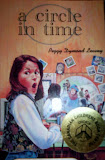Exactly one year ago, our writers' group lost one of our members. It hasn't been the same since. Wilma was the one who kept us on track, encouraged us to "soldier on" whenever one of us felt the sting of rejection.
The successful author of seven children's novels, as well as numerous short stories and a radio play, Wilma had had her share of rejections, but she never let anyone be discouraged for long. It was "pass the Kleenex" and get right on with the writing.
"History with a mystery" was how Wilma E. Alexander described her fiction. As was our custom at meetings, Wilma read novel number eight,
Finding Silver, to us, chapter by chapter over the months, looking for suggestions and hearing how it sounded read aloud. We listened and made our comments. We all loved it.
Wilma had a wonderful sense of story. She and I used to toss around, half-jokingly, the idea of collaborating on something one day. My books are character-driven; I spend a great deal of time developing characters and letting them decide where we're going. On the other hand, Wilma had this wonderful ability to weave the most intriguing plots.
She had completed this eighth novel for young readers and was shopping it around to various publishers when she became ill. Before we knew it, she was gone. Her final wish, according to her husband, Jim, was that he publish
Finding Silver himself.
This week, Wilma's wish came true, and Jim accepted delivery of Wilma's last novel from the printer. He had taken great care in selecting a publisher and in arranging for editing and proof- reading of the manuscript. Only another writer can appreciate what a labour of love this was.
The finished book looks most professional. Wilma would be proud. Besides the fascinating story inside, the book is attractively designed with an eye-catching cover. It is well-bound and has a reader-friendly typeface that will appeal to children.
Thanks to Jim Alexander's generosity, every school and library in a wide area will receive copies of
Finding Silver at no charge. Any proceeds from further sales of the book will go directly to the Canadian Cancer Society, in Wilma's memory.
Soldier on, fellow writers.
 The cover illustration for Growing Up Ivy has arrived. The book, due to be released in June, 2010 is my latest novel for readers 10 years and over. I love the illustration Dundurn has chosen for its cover.
The cover illustration for Growing Up Ivy has arrived. The book, due to be released in June, 2010 is my latest novel for readers 10 years and over. I love the illustration Dundurn has chosen for its cover.









